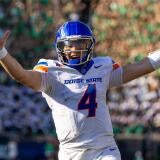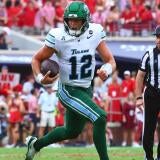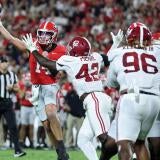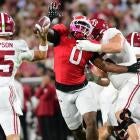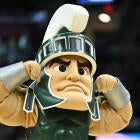Jaylon Smith's insurance payout could lead to more players skipping bowl games
The ex-Notre Dame star may have started a change in postseason college football

Download the CBS Sports App today and get the latest offseason college football news and alerts plus previews of the upcoming season!
Former Notre Dame linebacker Jaylon Smith has become at least the fourth highly-rated player in the last 18 months to collect on his loss of draft value insurance policy, two sources told CBS Sports.
But that is less of a story than the implications of Smith’s payout -- believed to be $700,000. Will the increasing availability of such insurance and seeming frequency of payouts make it more likely that more players will be skipping bowl games?
“What you saw is the tip of the iceberg,” said Bryan Fisher, a Baton Rouge, Louisiana-based attorney who works with college players vetting insurance. “You’re going to see a lot of kids skipping.”
Much was made of Stanford’s Christian McCaffrey and LSU’s Leonard Fournette skipping their teams’ bowl games because of injury concerns.
Their loyalty was questioned by some even though McCaffrey touched the ball more than 800 times at Stanford. Fournette had been nicked up at LSU but was considered a workhorse himself.
Meanwhile, a cottage insurance industry has grown up around top-rated college football players in recent years. CBS Sports reported last year Fournette had separate $10 million policies for total disability and loss of value.
Even if Fournette collected on those policies, he’d get a fraction of what he would earn as long-time healthy NFL player. So does this mean the less football played, the better?
“I would probably say more young men will be cognizant that that is a reality,” said Ronnie Kaymore, CEO of Kaymore Sports Risk Management, who advises players on such matters.
Smith joins Oregon’s Ifo Ekpre-Olomu, Iowa State’s E.J. Bibbs and USC’s Silas Redd as known players who have collected on their loss of value policies since 2015.
Kaymore estimates $8 million combined has been paid to players with loss of value claims in the past six years.
The relatively new loss of value policy protects a player if his draft stock plummets due to injury. Smith tore his ACL and MCL and suffered nerve damage in the 2016 Fiesta Bowl against Ohio State.
The devastating injury probably cost him millions due to a first-round projection. Some projected his first contract would be worth $20 million.
Smith was the third player taken in the second round -- No. 34 overall -- by the Dallas Cowboys in the 2016 draft. In December, he was put on season-ending injured reserve, missing his first NFL season.
Smith’s insurance policy states if he did not receive an NFL offer that was at least $7.2 million for four years, he would be covered for loss of draft value. His current contract with the Cowboys is for four years, $6.495 million.
The difference equals his $705,000 payout.
But a clause in the policy states Smith must pay back that amount if his total compensation exceeds $7.2 million. That could easily happen when and if Smith gets to his second contract.
The so-called “clawback” provision essentially can render moot the value of a loss of value payout.
“Insurance policies are not designed to pay out,” one industry insider said.
Anyone who has made any major insurance claim probably knows. The insurance company has the leverage. One insurance industry insider suggested the best way to fight the clawback provision is simply refuse to pay it.
The clawback money then could become a negotiable issue where the insurance settles for pennies on the dollar.
“There’s no real regulation of the policies,” Fisher said. “Is that insane? You’ve got an actual realized loss this year and this policy is intended to cover it. Yeah, but guess what you’re going to have to pay the money back.”
The risk of not being insured, though, can be devastating. South Carolina Marcus Lattimore retired from the NFL in 2014 after two devastating knee injuries suffered in college. He never played a professional down and collected much of $1.7 million owed him on a disability policy.
The discussion, then, perhaps shouldn’t be about McCaffrey and Fournette but perhaps Michigan’s Jake Butt. The tight end suffered a torn ACL in the Orange Bowl. Butt is believed to have loss of value insurance. In hindsight, it would have better to sit out.
“The fact that players can’t get enough coverage and it’s cost prohibitive to get the coverage, all of those things you’ve seen are the tip of the iceberg,” Fisher reiterated. “You’re going to see more kids opting out. That could change the tide.”
The NCAA began making career-ending insurance available to players 27 years ago. An NCAA official said less than a dozen athletes have ever collected.
The NCAA allows players to borrow against their future earnings to pay for the premiums. Smith paid $55,000 for his premiums, CBS Sports has learned.
The market for such unique policies is small. Typically, only those players rated in the top three rounds of the draft can get such policies. After that, it’s not worth it to the insurers.
In the last four years, schools have begun exploiting in a loophole in NCAA rules that allows them to pay those premiums. The Student Assistance Fund at each school is stocked by NCAA money. Typically, there is $300,000-$350,000 in that fund.
The practice of paying for premiums has become so common, that it has become a recruiting tool.
“You would have a difficult time managing recruiting without paying the premium for insurance for players,” Oklahoma State coach Mike Gundy said. “If I had a son that I thought could be that good, if you’re a school that can’t pay the premiums, he’s not going there.”

